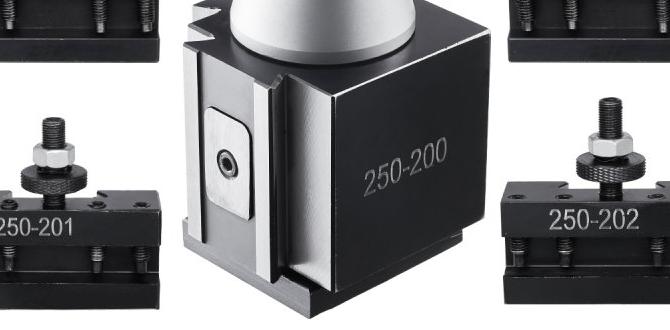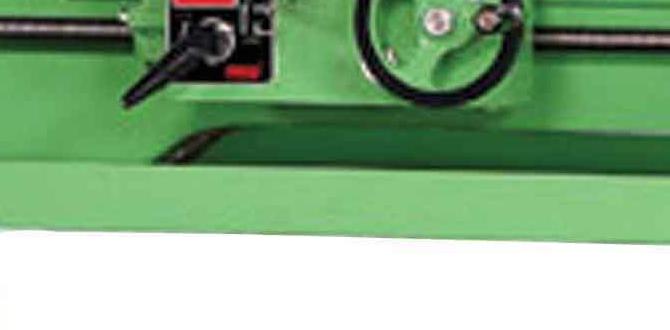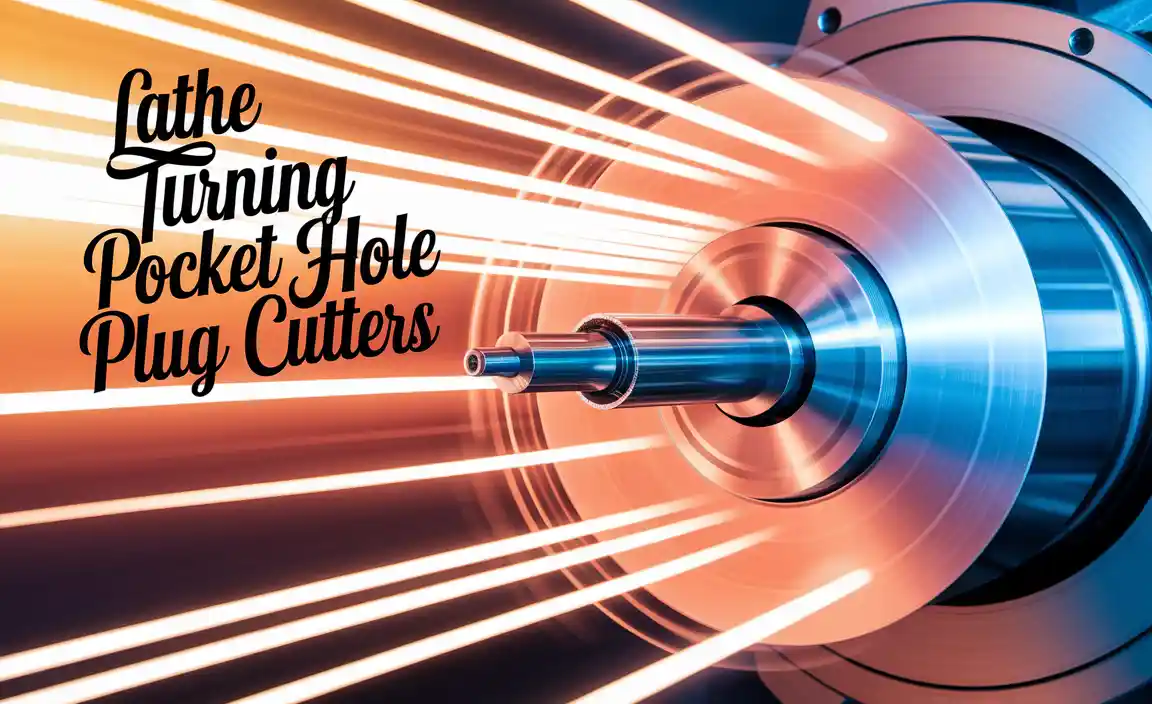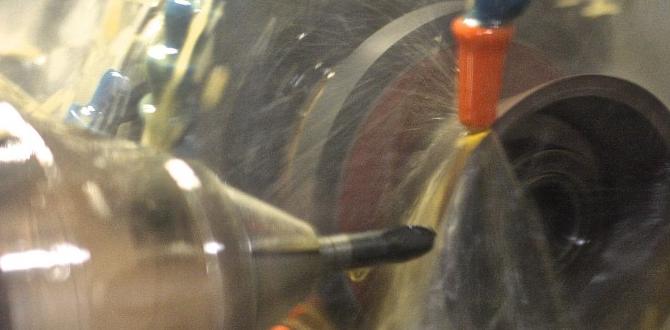Quick Summary:
A 1/8″ carbide end mill is a fantastic tool for cutting bronze. Its small size and specialized design allow for precise and efficient work in this often challenging material, making intricate cuts and detailed finishing easier and more accurate for hobbyists and professionals alike.
Hey there, workshop warriors! Daniel Bates here from Lathe Hub. Ever found yourself staring at a piece of bronze, wondering how to get those crisp, clean cuts you see in finished projects? It can feel a bit daunting, especially with a material that’s a little softer than steel but still has its own quirks. The good news? You don’t need a whole arsenal of complicated tools. Often, the secret weapon is something surprisingly small: a 1/8″ carbide end mill. This little powerhouse is a game-changer for tackling intricate work in bronze. We’re going to dive deep into why it’s so effective and how you can use it to achieve stunning results. Get ready to unlock some serious precision!
The Magic Behind a 1/8″ Carbide End Mill for Bronze
So, what makes this specific tool, the 1/8″ carbide end mill, such a star for bronze machining? It boils down to a few key characteristics that work together beautifully. Think of it as a perfectly matched set of skills for a particular job.
Material Matters: Why Carbide?
First off, let’s talk about the “carbide” part. Carbide, or tungsten carbide, is an incredibly hard and durable material. This is crucial for cutting tools. Unlike high-speed steel (HSS), carbide can withstand much higher temperatures without losing its hardness. When you’re cutting metal, friction creates heat. Bronze, while not the hardest metal, can still generate enough heat to dull a less robust tool quickly. Carbide’s resistance to heat means your end mill stays sharp for longer, leading to cleaner cuts and a better finish on your bronze workpiece. This durability translates to less tool wear, fewer tool changes, and ultimately, more efficient machining time.
The Precision of 1/8″
Now, consider the size: 1/8 inch. This incredibly small diameter is where the “genius” in our title comes in. For bronze, especially when you need to create intricate designs, fine details, or work within tight spaces, a standard-sized end mill can be overkill. A 1/8″ end mill offers unparalleled precision. It allows you to:
- Make very fine slotting cuts.
- Create intricate internal corners and details.
- Profile small, detailed shapes.
- Work on smaller workpieces where larger tools would be impractical.
- Achieve a high level of surface finish suitable for decorative or functional parts.
This miniature size is perfect for model making, jewelry fabrication, intricate engraving, or any project where detail is paramount. It’s the difference between a broad stroke and a fine-tipped pen for your metalworking canvas.
Long Reach & Bronze Specifics
The phrase “long reach” often comes up with these smaller end mills. While a standard 1/8″ end mill might have a short flute length, “long reach” versions are designed with an extended shank. This allows the cutting flutes to reach deeper into cavities or workpieces without the shank colliding with the material. For bronze, especially if you’re working on more complex parts or need to machine internal features, a long reach end mill can be indispensable. It provides the clearance needed to make those deeper cuts cleanly and safely. Bronze itself is a copper alloy, often containing tin, aluminum, or manganese. While it’s considered a “gummy” material by some machinists – meaning it can be prone to sticking to tools – the sharp cutting edges of a carbide end mill, combined with proper speeds and feeds, can manage this effectively. You’ll often find specific end mills designed for softer, non-ferrous metals like bronze, which might have fewer flutes and a polished flute surface to help with chip evacuation and prevent material buildup.
Choosing Your 1/8″ Carbide End Mill: What to Look For
Not all 1/8″ carbide end mills are created equal, especially when targeting a material like bronze. To get the best results, you need to be a bit discerning. Here’s what to keep an eye out for when you’re shopping:
Flute Count: The Brains of the Operation
The number of flutes (the spiral cutting edges) on an end mill significantly impacts its performance. For softer, ‘gummy’ materials like bronze:
- 2-Flute End Mills: These are generally the best choice for non-ferrous metals like aluminum and bronze. With fewer cutting edges, they provide more clearance for chips to escape. This is crucial because if chips — small pieces of removed material — get packed into the flutes, they can cause jamming, poor surface finish, and even break the tool. The larger chip gullets in a 2-flute design help prevent this.
- 4-Flute End Mills: While great for harder materials and a smoother finish in steel, they can sometimes overload with chips in softer metals like bronze. If you’re using a 4-flute end mill, you’ll need to be very careful with your feed rates and depth of cut, and ensure excellent chip evacuation.
For most beginner applications with bronze, a 2-flute end mill is the safer and more forgiving bet.
Coating: The Extra Edge
While plain carbide is good, some end mills come with special coatings. For bronze, look for uncoated carbide or mills with coatings designed for non-ferrous materials. Coatings like ZrN (Zirconium Nitride) or AlTiN (Aluminum Titanium Nitride) can improve performance, but for bronze, a highly polished, uncoated carbide is often preferred as it minimizes friction and chip adhesion. Always check the manufacturer’s recommendations for the material you’re cutting.
Shank Type: Gripping Power
The shank is the part of the end mill that the tool holder grips. For a 1/8″ end mill, you’ll typically see a 1/8″ shank. However, some might have a slightly larger shank (e.g., 1/4″ or 6mm) for better rigidity if your milling machine’s collet system can accommodate it. Ensure the shank diameter matches your collet or tool holder perfectly to avoid runout (wobble), which will ruin your finish and potentially break the tool.
Reach Length: Getting Deep
As mentioned, “long reach” end mills are designed for deeper cuts. If your project involves machining into a cavity or a part with significant depth relative to its width, a long reach end mill is essential. Standard end mills have a cutting length that’s only a few times their diameter. Long reach can be significantly longer, providing the necessary clearance.
Heat Resistance: A Key Benefit
While we’ve touched on carbide’s inherent heat resistance, it’s worth reiterating. Bronze can build up heat quickly. A tool that can handle this heat without softening is vital. Carbide excels here, allowing you to maintain consistent cutting speeds and achieve better results without constantly pausing to let the tool cool down.
Essential Companion Tools for 1/8″ Bronze Cutting
Using a precision tool like a 1/8″ carbide end mill effectively requires the right support system. It’s not just about the end mill itself; it’s about how you integrate it into your machining setup. Think of it as a star athlete needing a great team to perform at their best.
The Milling Machine
You’ll need a milling machine capable of holding and accurately spinning a 1/8″ end mill. This could range from a small benchtop CNC mill to a larger industrial machine. Key considerations include:
- Spindle Taper and Collets: Ensure your machine has a collet system that can accept 1/8″ end mills (e.g., R8, ER collets). A precise collet is critical to prevent runout.
- Variable Speed Control: Being able to adjust spindle speed is vital for optimizing cutting parameters for bronze with different end mills.
- Rigidity: A stable and rigid machine will provide the best surface finish and prevent chatter.
Tool Holders and Collets
Your end mill needs a secure and accurate home. This means high-quality collets and tool holders. For such a small tool, an ER collet chuck is often ideal for providing excellent runout accuracy. A worn or imprecise collet is a recipe for disaster when working with small, delicate cutting tools.
Workholding: Holding Your Bronze Securely
This is paramount. Your bronze workpiece must be held absolutely firmly. Any movement during cutting will lead to poor finish, inaccurate dimensions, or even tool breakage. Common workholding methods include:
- Vises: A good quality milling vise, especially one with hardened and ground jaws, is essential. Consider using soft jaws if you need to protect the surface of your bronze.
- Clamps: For irregularly shaped pieces or when an end mill needs to cut close to the edge, specialized clamps might be necessary.
- Fixtures: For production runs or complex shapes, custom fixtures are often used.
Coolant/Lubricant: The Essential Helper
While some machinists dry-mill bronze, using a coolant or lubricant significantly improves cutting performance, tool life, and surface finish. For bronze, a lubricant specifically designed for non-ferrous metals is best. This helps:
- Cool the cutting edge, preventing heat buildup.
- Lubricate the interface between the tool and the workpiece, reducing friction.
- Flush away chips, improving chip evacuation.
A good flood coolant system or a spray mist system can make a huge difference. For very small, hobbyist setups, a manual application of a suitable cutting fluid with a brush can also be effective.
Measurement Tools
Precision is key, so have your measuring tools ready:
- Calipers (digital or dial)
- Micrometers (for very precise measurements)
- Edge finder or probe (for setting tool offsets precisely on CNC machines)
Safety Gear: Non-Negotiable
Always, always, always:
- Wear safety glasses or a face shield.
- Wear appropriate ear protection.
- Avoid loose clothing or jewelry that can get caught.
Mastering the Cut: Speeds, Feeds, and Techniques
Now for the exciting part: actually using that 1/8″ carbide end mill on bronze! Getting the “speeds and feeds” right is crucial for success. Don’t let these terms scare you; they are just simple ways to control how fast the tool spins and how fast it moves through the material.
Understanding Speeds and Feeds
Here’s a quick breakdown:
- Spindle Speed (RPM): This is how fast the end mill rotates. Measured in revolutions per minute (RPM).
- Feed Rate: This is how fast the end mill moves into and through the material. Measured in inches per minute (IPM) or millimeters per minute (MM/min).
- Chip Load: This is arguably the most critical factor. Chip load is the thickness of the material removed by each cutting edge of the end mill per revolution. A good chip load ensures the tool is cutting efficiently, not scrubbing or burning.
Calculating Speeds and Feeds for Bronze
Bronze can vary in hardness, so these are general guidelines. For a 1/8″ (0.125″) carbide end mill, especially one with 2 flutes designed for aluminum and bronze, here’s a starting point:
Surface Speed (SFM): Carbide end mills designed for aluminum and bronze often have recommended surface speeds ranging from 300 to 700 SFM (Surface Feet per Minute). Let’s aim for the middle, around 500 SFM, for a good balance.
Calculating RPM:
The formula is: RPM = (SFM × 12) / (π × Diameter)
Where:
SFM = 500 ft/min
Diameter = 0.125 inches
π (Pi) ≈ 3.14159
So, RPM = (500 × 12) / (3.14159 × 0.125) = 6000 / 0.3927 ≈ 15,279 RPM
This RPM might be very high for some benchtop mills. In such cases, you’ll have to work with the maximum RPM your machine offers and adjust the feed rate accordingly. If your machine tops out at, say, 10,000 RPM, you’ll use that and a slower feed rate.
Chip Load: A good starting chip load for a 1/8″ 2-flute carbide mill in bronze might be around 0.001″ to 0.002″ per flute. Let’s aim for 0.0015″ per flute.
Calculating Feed Rate:
The formula is: Feed Rate (IPM) = RPM × Number of Flutes × Chip Load per Flute
Using our calculated RPM (if possible) of 15,279 RPM:
Feed Rate = 15,279 × 2 × 0.0015 ≈ 45.8 IPM
If your machine can only do 10,000 RPM, and you want to maintain a similar chip load to avoid scrubbing:
Feed Rate = 10,000 × 2 × 0.0015 ≈ 30 IPM
Depth of Cut (DOC): For a 1/8″ end mill, especially a long reach one, you don’t want to take aggressive cuts. Start conservatively.
- Radial Depth of Cut (Stepover): How much the end mill moves sideways for each pass. For roughing, 50% of the diameter (0.0625″) is common. For finishing, 10-25% (0.0125″ – 0.03125″) is better for surface finish.
- Axial Depth of Cut (Pass Depth): How deep the end mill cuts into the material on each Z-axis move. For a 1/8″ end mill, start with 0.0625″ to 0.125″ for roughing. For finishing passes, take very shallow cuts, perhaps 0.005″ to 0.010″.
Key Techniques for Bronze Machining
- Use a Lubricant: As mentioned, a cutting fluid specifically for non-ferrous metals is highly recommended.
- Climb Milling vs. Conventional Milling: For most operations, especially with CNC machines, climb milling often yields better results on bronze. In climb milling, the cutter rotates in the same direction as the feed. This results in a thinner chip at the start of the cut and a thicker chip at the end, leading to an improved surface finish and less tool pressure. Conventional milling can sometimes dig into softer materials.
- Peck Drilling: If you’re plunging the end mill into the material (drilling a hole), use a peck drilling cycle (if on CNC) or manually retract the tool periodically to clear chips.
- Multiple Passes for Finishing: To achieve a mirror-like finish, make a spring pass (a finishing pass with a very light depth of cut, like 0.002″ to 0.005″) after your final roughing or semi-finishing pass.
- Tool Break-in: For expensive carbide tools, it’s sometimes recommended to take a slightly lighter cut for the very first pass to help “burnish” or break in the cutting edges gently.
Remember: These are starting points. Always listen to your machine and tool. If you hear chattering, see poor chip formation, or notice excessive heat, adjust your speeds and feeds. Slower spindle speed and a slower feed rate are generally safer for beginners. You can find many online CNC calculators provided by tool manufacturers (like GSSpeedsandFeeds or specific manufacturer sites) that can help you calculate these parameters based on your exact tooling and machine.
A Pro Tip Table for Bronze Machining
To make things even clearer, here’s a handy reference table. Think of this as your quick-start guide for getting those perfect bronze cuts.
| Operation | Tool Type | Spindle Speed (RPM) (per 10,000 RPM machine) |
Feed Rate (IPM) (per 10,000 RPM machine) |
Axial DOC (in) | Radial DOC (Stepover %) | Lubrication | Notes |
|---|---|---|---|---|---|---|---|
| Pocketing / Slotting (Roughing) | 1/8″ 2-Flute Carbide Bronze/Aluminum Optimized |
10,000 | 25 – |







